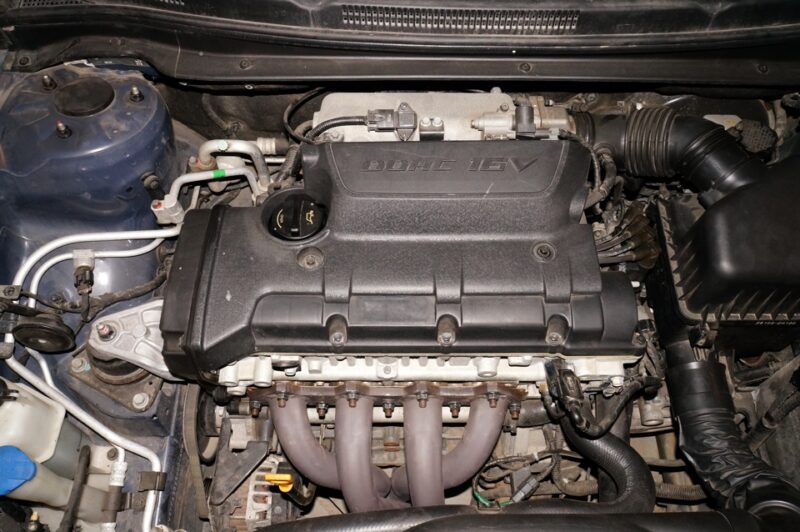Specifications
Manufacture – Ulsan plant
Engine brand G4GC
Years of production – (2001 – 2012)
Cylinder block material – cast iron
Power system – injector
Type – in-line
Number of cylinders – 4
Valves per cylinder – 4
Piston stroke – 93,5 mm
Cylinder diameter – 82 mm
Compression ratio – 10.1
Engine displacement – 1975 cm. cc.
Engine power – 137-143 hp /6000 rpm
Torque – 184Nm/4500 rpm
Fuel – 92
Ecological norms – Euro 4
Engine weight – 144 kg
Fuel consumption – city 9,3 l. | highway 7,1 l. | mixed. 5,9 l/100 km
Oil consumption – up to 1 liter/1000 km (in severe conditions)
Oil for g4gc engine: 10W-30, 10W-40
How much oil in the G4GC engine: 4 liters.
When changing, pour up to MAX.
Oil change is carried out once in 15000 km(better 7500 km).
G4GC engine life:
1. According to the factory – 300 thousand km.
2. In practice – 300+ thousand km.
TUNING
- Potential – 200+ hp
- Without loss of resource ~ 150-155 hp.
The engine was installed on:
- Kia Ceed
- Kia Cerato
- Kia Spectra
- Kia Sportage
- Hyundai Elantra
- Hyundai i30
- Hyundai Tucson
- Hyundai Soul
- Hyundai Sonata EF
- Hyundai Coupe
- Hyundai Trajet
- Kia Carens
Troubleshooting and repair of the G4GC 2.0L engine
G4GC engine is the senior model of Beta II family and the continuation of G4GF, produced since 1997, in the engine was changed the cylinder block, modified crankshaft (8 counterweights instead of 4), changed the cylinder head and combustion chamber, another gasket and the cylinder head itself, the engine mounts themselves, the catalytic converter, etc. G4GC engines are equipped with a CVVT intake shaft timing system, but not equipped with hydrocompensators, the motor requires adjustment of valve clearances once every 90 thousand kilometers. Therefore, if there are characteristic engine knocks, do not worry, most likely it is unadjusted valves. In practice, many drive more than 150 thousand km without adjusting the clearances and there are no problems, but this is wrong. The timing belt drive and to avoid breakage, bent valves and other goodies, you need to change the belt and rollers once every 60 thousand km. Again, many people drive more than 100 thousand km on one belt, but such economy, sooner or later, will come to a bad end.
This is all good, let’s see the drawbacks and faults …
The most obvious and noticeable, G4GC is more noisy, relative to past models of motors and is prone to various vibrations, its peculiarity is the sound of work similar to diesel, it is normal.

Not less popular disadvantages are the problems of jerking both at idle and during acceleration and braking, as well as stalling during acceleration. The problem is partially solved by replacing the ignition coil, if it does not help, change the BB wires and plugs.
There is a problem with revolutions freezing and is solved by firmware, go to the service, they are familiar with it, you are not the first, you are not the last.
These are the main and frequent problems of the G4GC engine, the other cases are private.
To summarize, the motor G4GC can be called successful, due to its simplicity and unpretentiousness, reliability, durability and cheapness of spare parts it is definitely a good and trouble-free choice.
Over time, the Beta series engines have been superseded by the new and more powerful Theta family.
Engine number
The G4GC engine number is stamped on the cylinder block on the right side, above the transmission, grab a mirror to view it.
G4GC engine tuning
Chip tuning
Simple firmware promises you about 150 hp, and whether they will be or not is unknown, it will be more reliable to put a straight-through exhaust, spider 4-2-1 and shafts phase 268/264 or camshafts from the motor 1.8 G4GM with a large lift. These small modifications after tuning will provide up to 160 hp and with it the character of the motor will become more sporty.
Compressor and turbine
To drive the car long, fast and happy, the motor needs to be squeezed, because the compression ratio of 10.1 for supercharging is high. In this will help us forged piston with a well under SJ 8.5-8.8, then we need injectors of greater capacity ~650cc more than enough, exhaust on the pipe 60-63mm, shafts phase 264, further if we put a compressor, then put some Eaton with a pressure of 0.7-1 bar and go to adjust, if the turbine, popular TD04 for example, then you need to cook under it manifold and a lot of other related. As a result, it is possible to remove 200 hp on the compressor without problems, on the turbine more, but also more fiddling.
Those who are interested in consumption … it will be higher, those who are interested in resource – it will be lower, depending on the operation.
ENGINE RATING: 4
